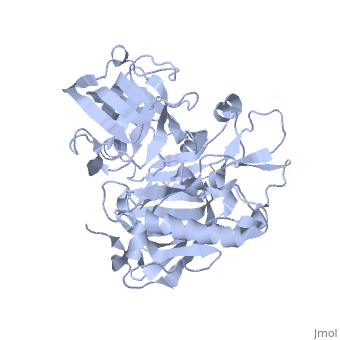Beta Secretase (BACE1) 1SGZ
From Proteopedia
| Line 1: | Line 1: | ||
| - | Beta-secretase, also known as '''BACE''' or '''Memapsin 2''', is encoded by the gene BACE1. Beta-secretase is a proteolytic, transmembrane enzyme with two active sites on the extracellular region. It is associated with processing amyloid precursor protein (APP), which is an integral membrane protein. A malfunction in the processing of APP results in the formation of the peptide amyloid-beta. Amyloid-beta is a neurotoxic peptide segment that aggregates into plaques. These plaques are the primary component of plaques found in individuals with Alzheimer’s disease. '''Other biological associations of this enzyme include modulating myelination in the central and peripheral nervous systems.''' | + | Beta-secretase, also known as '''BACE''' or '''Memapsin 2''', is encoded by the gene BACE1. Beta-secretase is a proteolytic, transmembrane enzyme with two active sites on the extracellular region. It is associated with processing [[amyloid precursor protein]] (APP), which is an integral membrane protein. A malfunction in the processing of APP results in the formation of the peptide [[amyloid-beta]]. Amyloid-beta is a neurotoxic peptide segment that aggregates into plaques. These plaques are the primary component of plaques found in individuals with [[Alzheimer’s disease]]. '''Other biological associations of this enzyme include modulating myelination in the central and peripheral nervous systems.''' |
== Enzyme Class == | == Enzyme Class == | ||
| - | Beta-secretase is an enzyme that is classified as a class 3 enzyme, which are hydrolase enzymes. It acts on breaking peptide bonds and therefore is also considered a peptidase and belongs to the subclass of aspartic acid endopeptidases. | + | Beta-secretase is an enzyme that is classified as a class 3 enzyme, which are [[hydrolase enzymes]]. It acts on breaking peptide bonds and therefore is also considered a peptidase and belongs to the subclass of aspartic acid endopeptidases. |
== Structure == | == Structure == | ||
Revision as of 13:03, 5 April 2016
Beta-secretase, also known as BACE or Memapsin 2, is encoded by the gene BACE1. Beta-secretase is a proteolytic, transmembrane enzyme with two active sites on the extracellular region. It is associated with processing amyloid precursor protein (APP), which is an integral membrane protein. A malfunction in the processing of APP results in the formation of the peptide amyloid-beta. Amyloid-beta is a neurotoxic peptide segment that aggregates into plaques. These plaques are the primary component of plaques found in individuals with Alzheimer’s disease. Other biological associations of this enzyme include modulating myelination in the central and peripheral nervous systems.
Enzyme Class
Beta-secretase is an enzyme that is classified as a class 3 enzyme, which are hydrolase enzymes. It acts on breaking peptide bonds and therefore is also considered a peptidase and belongs to the subclass of aspartic acid endopeptidases.
Structure
| |||||||||||
References
- ↑ Hanson, R. M., Prilusky, J., Renjian, Z., Nakane, T. and Sussman, J. L. (2013), JSmol and the Next-Generation Web-Based Representation of 3D Molecular Structure as Applied to Proteopedia. Isr. J. Chem., 53:207-216. doi:http://dx.doi.org/10.1002/ijch.201300024
- ↑ Herraez A. Biomolecules in the computer: Jmol to the rescue. Biochem Mol Biol Educ. 2006 Jul;34(4):255-61. doi: 10.1002/bmb.2006.494034042644. PMID:21638687 doi:10.1002/bmb.2006.494034042644

